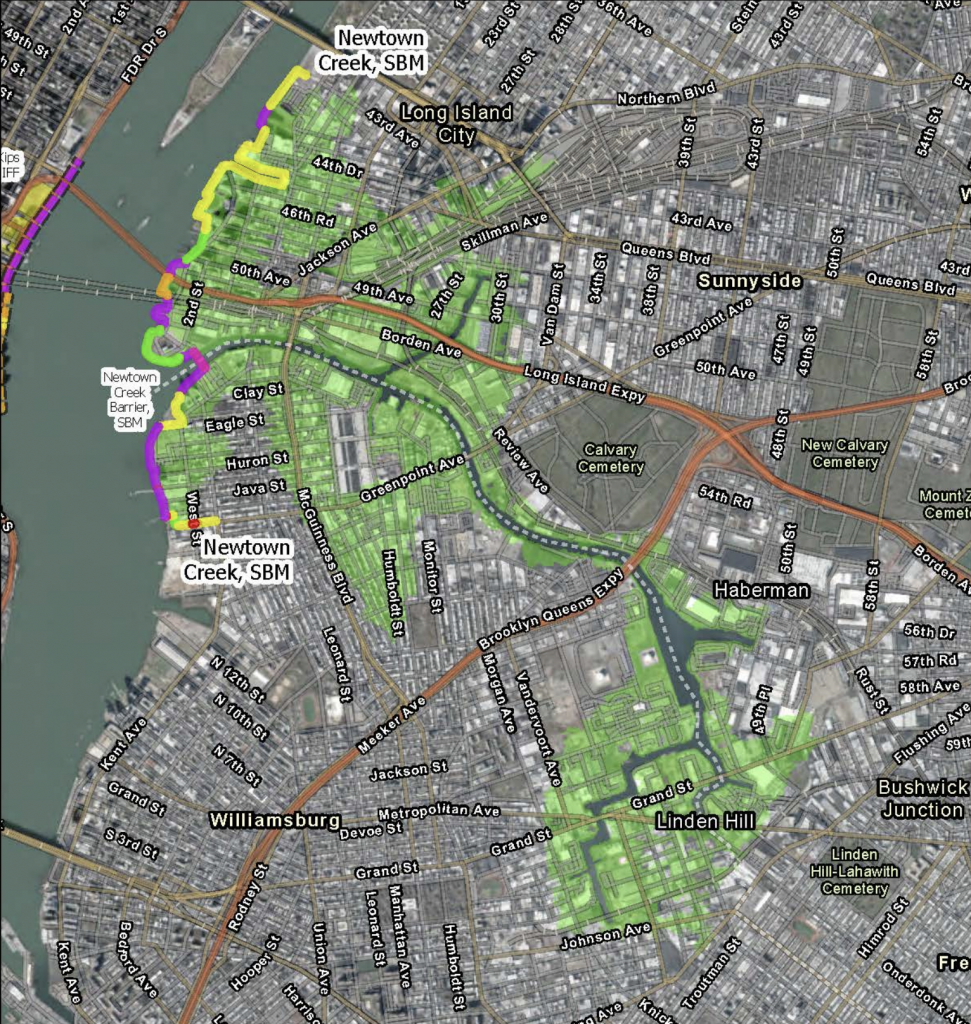Newtown Creek Alliance is reviewing a report released in October by the US Army Corps of Engineers (USACE) that proposes a plan with aims to protect the NY-NJ Harbor how to get levitra sample from coastal storm risks. The 569 page report is followed by 8 appendices split into: environmental, engineering, cost engineering, economics, maps, real estate, public and agency coordination, and stakeholder list sections. As we continue to examine the entirety of the document(s), we have identified multiple concerns with the current proposal:

Strangulation at the Mouth of Newtown Creek
The highly technical and heavily engineered systems proposed by Alternative 3B include: 12 storm surge gates and 41 miles of coastal walls and barriers throughout the New York and New Jersey watershed. One lowest price for viagra massive in-water barrier and gate is proposed near the mouth of Newtown Creek, which will fundamentally change the flow of waters to and from the Creek. The structure, as proposed, would reduce the existing 400’ wide opening to just 130’. We need to better understand how this permanent restriction to water flow would impact the Creek’s water quality, sediment deposition, fish and marine wildlife passage, Superfund remedies, as well as maritime and recreational use near the mouth. Both water quality data and the Superfund investigation have made clear that the already limited exchange of water to and from the East River provides significant benefit. We would like to see a plan that at least maintains current water exchange between the East River and Newtown Creek.
High Tide Flooding
Critically, this plan does not appear to address the full projected risks of sea level rise around Newtown Creek, as the storm surge gates would remain open except during storm conditions. Shoreline barriers would help by stopping or slowing waters along the East River, but the gates at the mouth of the Creek will not. High tide projections in 2080 will flood many areas along Newtown Creek, and, as visualized by their storm surge modeling StoryMap here, the storm surge gates will have no impact on expected “sunny-day flooding” along Newtown Creek’s 11 miles of shoreline. Though this plan is designed to protect the Creek, it is only effective during storm surge events and we cannot support a project that does not properly address sea level rise threats in Newtown Creek and New York Harbor.
Flooding from Within
Additionally, we are concerned that the proposed plan does not adequately address additional inputs to Newtown Creek during intense precipitation events and how to allow those volumes of water to properly enter into New York Harbor when the storm surge gate is closed. During large rain events, tens of millions of gallons of stormwater, combined sewer overflow, and partially treated effluent from the Newtown Creek Wastewater Treatment Plant enter the Creek from point sources beyond the proposed gate. We need more information about potential flooding that could occur within a closed off Newtown Creek when the storm surge barrier at the mouth is deployed. The Army Corps has discussed the potential need to construct pump stations but has not provided any analysis.
A Skewed Set of Alternatives
Originally, USACE created, evaluated, and compared five options for action, with alternative 3B–Multi-basin Storm Surge Barriers With Shore-Based Measures being selected. This is the midpoint of the agency’s proposed range of action from both large-scale in-water and on-land engineered systems (such as a barrier across the entire entrance of NY Harbor) to only on-land systems (bulkheads and seawalls as seen in Alternative 5). This range doesn’t include a comprehensive assessment of potential interventions, and actively excludes many interventions that we advocate for including green infrastructure and stormwater system upgrades (p.39 appendix B). We believe that a wider range of solutions needs to be considered by USACE, and that option 3B is not a true “compromise” but rather one selection from a skewed and limited spectrum of options.
Outdated Sea Level Data
We take an issue with the outdated nature of the inputs used for modeling these alternatives. Sea level rise projections used in the AdH model were created based on 1995 sea level, and other factors (like the impact an increased water-level could have on river flows) were excluded (appendix B7, 7). Mean sea level rise was calculated based on 1983-2001 data (appendix B6, 11), the 1992 Tidal Epoch, as the next dataset spanning 2002-2020 will not be available until 2025 according to the National Oceanic and Atmospheric Administration. This baseline excludes more relevant and recent storm events including Superstorm Sandy.
Lack of Details for East River Walls
Finally, while there are a number of general and site specific maps available in the report, there are not enough adequate details and visuals regarding how the Greenpoint and Long Island City waterfronts will be changed with the installation of seawalls and floodwalls. The project has significant potential to physically transform the existing shorelines and waterfront communities near the Creek. We firmly believe that residents and local stakeholders need real details about where and what these structures will consist of and how they will function.
——–
As advocates for Newtown Creek and our Creekshed communities, we are acutely aware of our need for coastal resilience. Unfortunately, this $52 billion plan will mitigate only part of our coastal storm surge risk and does not instill confidence that it will remain effective as storm surges and sea level rise increase. For these reasons we oppose this plan, and strongly support an alternative that considers existing conditions within the Creek and more broad-range approaches to both sea level rise and storm surge occurrences as we move quickly towards continued coastal disruptions and destruction.
We acknowledge the changes that have been made throughout the process already, and look forward to the continued evolution and design of this proposal, as well as the final plan that is approved by Congress. We look forward to working with partners and advocates to promote the health and wellbeing of Newtown Creek, and all of the coastal communities throughout the Study Area. In order to do so, we need to make sure that all of our issues with the plan are heard by the Army Corps through the public comment period, which extends through March 7, 2023.
The public is invited to submit comments by mail to:
NYNJHAT Study Team, Planning Division
U.S. Army Corps of Engineers
26 Federal Plaza, 17th Floor
New York, NY 10279-0090
or by e-mail to: NYNJHarbor.TribStudy@usace.army.mil
Please include the project title and the commenter’s contact information with submitted comments.
———–
Stay tuned for NCA’s formal comment letter, and a guidance document highlighting additional concerns and issues that may be of interest to community members.
In the meantime, learn more about the proposal, read the report, and explore visuals here, and read a recent article by Nathan Kensinger about the plan here.
